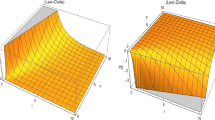Abstract
In this article, the perturbation theory is used to study the behaviour of the Universe after the Big Rip appears in the linearly varying deceleration parameter model. The study postulates that the pressure in the fluid has a huge impact on the evolution of the Universe from the beginning to the end as well as beyond. The flat model can reshape itself after a moment of the Big Rip due to the pressure change in the fluid, or perhaps the Universe will restructure itself and move to another Universe under the conditions of quantum physics. On the other hand, in the closed model, the moment of the Big Rip is continuous and cannot go back again to build its physical nature. Also, the physical behaviour of the open model cannot be accepted due to the special behaviour of both the energy density of the matter and the pressure of the fluid. The effect of pressure on the fluid of the Big Rip in the cosmological models, with linearly varying deceleration parameters and the periodic Universe of varying deceleration parameters of the second degree, is investigated. The study also extends the time of the Universe to be twice that of the first model in such a way as to be consistent with the second model when exploring the physical behaviour of the evolution of the Universe. Additionally, it gives us a visualisation of what happened to the Universe after the moment of the Big Rip. The two models help in explaining the positive pressure at the beginning of the Universe, as well as the negative pressure at the Big Rip. They expand the Universe to the moment of the Big Rip, and then the opposite pressure that forces the Universe to return to its beginning state.
























Similar content being viewed by others
References
Ö Akarsu and D Tekin, Int. J. Theor. Phys. 51(2), 612 (2012)
Ö Akarsu and D Tekin, Int. J. Theor. Phys. 51(10), 2995 (2012)
P K Sahoo, S K Tripathy and Parbati Sahoo, Mod. Phys. Lett.\(A\) 33(33), 1850193 (2018)
M A Bakry and A T Shafeek, Astrophys. Space Sci. 364(8), 135 (2019)
S R Prajapati, Astrophys. Space Sci. 331(2), 657 (2011)
Z Hussain et al, Pramana – J. Phys. 95(1), 1 (2021)
Y Wen and Y Xie, Pramana – J. Phys. 94, 18 (2020)
A Prakash, M Goyal and S Gupta, Pramana – J. Phys. 92(2), 18 (2019)
Weinberg Steven, Gravitation and cosmology (John Wiley & Sons, New York, 1972)
H P Robertson, Ann. Math. 496 (1932)
E F Taylor and John Archibald Wheeler, Am. J. Phys. 69, 1212 (2001)
M A Bakry, G M Moatimid and A T Shafeek, Indian J. Phys. 96(2), 619 (2022)
R R Caldwell, M Kamionkowski and N Nevin Weinberg, Phys. Rev. Lett. 91(7), 071301 (2003)
K E Avrachenkov, J A Filar and P G Howlett (eds), Analytic perturbation theory and its applications (Society for Industrial and Applied Mathematic, 2013)
J V Cunha and J A S Lima, Mon. Not. R. Astron. Soc. 390(1), 210 (2008)
J V Cunha, Phys. Rev. \(D\) 79(4), 047301 (2009)
M S Berman, Il Nuovo Cimento\(B\)74(2), 182 (1983)
M S Berman and Fernando de Mello Gomide, Gen. Relat. Grav. 20(2), 191 (1988)
M A Bakry and Aryn T Shafeek, Grav. Cosmol. 27(1), 89 (2021)
M I Wanas and M A Bakry, Astrophys. Space Sci. 228(1), 239 (1995)
A Eid, New Astron. 44, 17 (2016)
Acknowledgements
The authors extend their appreciation to the Deanship of Scientific Research at Imam Mohammad Ibn Saud Islamic University, KSA for funding this work through Research Group No. RG-21-09-42. The authors also would like to express their deep gratitude to Prof. M I Wanas for their deep interest and valuable comments during this work. The authors would like to express their deep gratitude to Dr Mustafa Ibrahim for English language review.
Author information
Authors and Affiliations
Corresponding author
Rights and permissions
About this article
Cite this article
Bakry, M.A., Eid, A. & Alkaoud, A. Notes on the Big Rip scenario in the linearly varying deceleration parameter model. Pramana - J Phys 96, 108 (2022). https://doi.org/10.1007/s12043-022-02345-8
Received:
Revised:
Accepted:
Published:
DOI: https://doi.org/10.1007/s12043-022-02345-8




